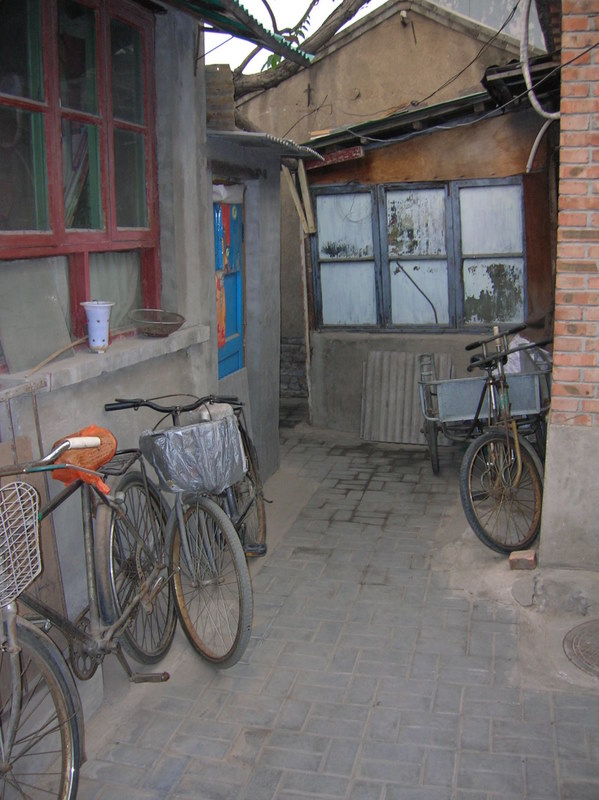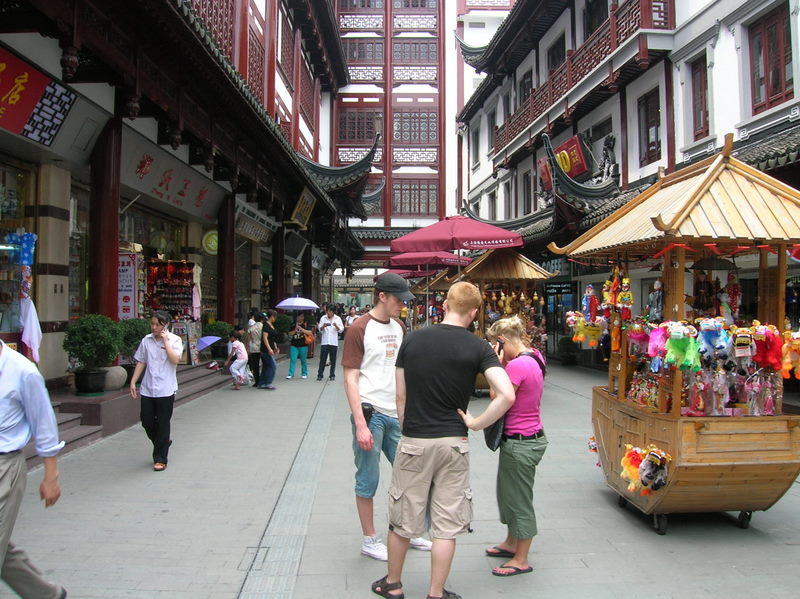Beijing's vanishing charm: for a buck, for better living conditions, and for a hefty price
 It's a bit mysterious to me how my fascination with China began; this far into it, I cant quite retrace the steps back to the beginning. But one of the first books I read about the country was journalist Ian Johnson's Wild Grass: Three Portraits of Change in Modern China, in which he deftly researches three different cases of citizens holding their own against a government that says a lot of things it does not follow through on. Johnson's reputation as a reporter and skill with Mandarin Chinese gave him a great launching point for these tales, and the people who spoke to him no doubt wanted to have their stories heard by others, outside their native land--where they'd been received coolly. One section focuses on a peasant lawyer's confrontation of government corruption and its exploitation of over-taxed farmers; another highlights the controversy surrounding Falun Gong, the physical and spiritual practice that was banned and some of its practitioners unduly prosecuted.
It's a bit mysterious to me how my fascination with China began; this far into it, I cant quite retrace the steps back to the beginning. But one of the first books I read about the country was journalist Ian Johnson's Wild Grass: Three Portraits of Change in Modern China, in which he deftly researches three different cases of citizens holding their own against a government that says a lot of things it does not follow through on. Johnson's reputation as a reporter and skill with Mandarin Chinese gave him a great launching point for these tales, and the people who spoke to him no doubt wanted to have their stories heard by others, outside their native land--where they'd been received coolly. One section focuses on a peasant lawyer's confrontation of government corruption and its exploitation of over-taxed farmers; another highlights the controversy surrounding Falun Gong, the physical and spiritual practice that was banned and some of its practitioners unduly prosecuted.
 The third story captures the overwhelming changes residents of the Old City of Beijing faced as their leaders began razing their artery-like system of winding neighborhoods, or hutong, which are simultaneously a relic of Chinese culture and character and a fast-decaying, dilapidated part of the modernizing city. He emphasizes the evicted hutong residents' situation, as most are not paid appropriately for their loss, cannot afford bigger, newer apartments--nor the commute hours into the city--and will be unable to replace the strong community that has surrounded many of them for their entire lives.
The third story captures the overwhelming changes residents of the Old City of Beijing faced as their leaders began razing their artery-like system of winding neighborhoods, or hutong, which are simultaneously a relic of Chinese culture and character and a fast-decaying, dilapidated part of the modernizing city. He emphasizes the evicted hutong residents' situation, as most are not paid appropriately for their loss, cannot afford bigger, newer apartments--nor the commute hours into the city--and will be unable to replace the strong community that has surrounded many of them for their entire lives.
This third one sprung up in my mind as I arrived in Beijing with a study abroad group in May 2007, and I even got to see one of these tight-knit and close-quartered communities myself, with part of what I'm sure was a choreographed tour for tourists. This didn't matter so much to me, as the hutong was the most charming thing I saw in the capital city, and I even made their rapid disappearance the subject of a paper for one of my classes while I was there. (Here's a post from my first encounter with the hutong.)
Unfortunately, the story has only gotten worse since Johnson's reporting, and since my visit three years ago. Government and business developers see the single-level, "dangerous" housing as an obstacle in the way of economic growth in the city, as things can be built upwards and sold as commercial space for much higher prices than any residential buildings could garner. What acres do becomes private homes will land in the price range of millionaires, out of reach to the hundreds of thousands of men and women who grew up on that same ground.
 I happened again upon this subject recently, as Amazon.com had a highly-rated memoir The Last Days of Old Beijing by Michael Meyer, in its bargain bin, and I needed something to accompany me on my summer travels. Meyer lived in Dazhalan, one of the hutong, and worked as a teacher at Coal Lane Elementary, and his neighbors, students, and anecdotes make for a lively portrait of this community that sits at the intersection of its city's past and future. It is deemed a "historic" area, and is labeled as one of the twenty-five protected parts of Old Beijing; but as he and his neighbors witness, this does not mean their homes and businesses are safe from The Hand, as he calls it-- the mysterious force that comes in the night and paints the large, white character on your door, that one that means it's slated for immanent demolition. There's not much the residents can do to stop the momentum, and posted advertisements remind each day of the benefit residents will bring to their city by taking their compensation and moving to the 'burbs--the sooner, the better for all parties.
I happened again upon this subject recently, as Amazon.com had a highly-rated memoir The Last Days of Old Beijing by Michael Meyer, in its bargain bin, and I needed something to accompany me on my summer travels. Meyer lived in Dazhalan, one of the hutong, and worked as a teacher at Coal Lane Elementary, and his neighbors, students, and anecdotes make for a lively portrait of this community that sits at the intersection of its city's past and future. It is deemed a "historic" area, and is labeled as one of the twenty-five protected parts of Old Beijing; but as he and his neighbors witness, this does not mean their homes and businesses are safe from The Hand, as he calls it-- the mysterious force that comes in the night and paints the large, white character on your door, that one that means it's slated for immanent demolition. There's not much the residents can do to stop the momentum, and posted advertisements remind each day of the benefit residents will bring to their city by taking their compensation and moving to the 'burbs--the sooner, the better for all parties.
"Historic" in the eyes of the commercial and governmental developers means razing the dilapidated building that has been neglected for half a century and replacing it with an "authentic" facsimile, with upturned eaves painted classic Chinese colors: reds, golds, greens. Qianmen, a fabled shopping district in the center of the city that has been replaced with a swanky doppelganger, is mourned by urban planning professor Yao Yuan in a July 20 article in the New York Times. "The renovation of Qianmen wasn't about preserving history, but about creating a fake Hollywood version of it," he said.
 This inclination to the reproduction was already firmly in place when I visited, specifically at the Shaolin Temple--famous for its kung fu masters--where we learned (subtly, this was not widely advertised information) that while the temple was on the location of the original, the one we were visiting was built in the 1980s. That news deflates the excitement a bit. So, it's slightly older than me? Such reproduction was also obvious in Shanghai, an entire city which aims to please the tourist and attempts to blend its western and eastern influences into something unique. A bustling old-style system of alleyways and tiny stores was less charming with its fresh paint coats, air conditioning, and Haagen-Dazs shop.
This inclination to the reproduction was already firmly in place when I visited, specifically at the Shaolin Temple--famous for its kung fu masters--where we learned (subtly, this was not widely advertised information) that while the temple was on the location of the original, the one we were visiting was built in the 1980s. That news deflates the excitement a bit. So, it's slightly older than me? Such reproduction was also obvious in Shanghai, an entire city which aims to please the tourist and attempts to blend its western and eastern influences into something unique. A bustling old-style system of alleyways and tiny stores was less charming with its fresh paint coats, air conditioning, and Haagen-Dazs shop.
I'm not here to pass judgment or even complain, really, because some of those modern amenities made my visit more comfortable, and surely improves the living conditions and salaries of many of China's urban dwellers. But as many others have asked before me, at what cost are these things forming? Is a newly-built shopping center doing the people of Beijing much more good than its previous shopping center? Is it really a part of the city's history that could not have been preserved more carefully from the start? Many of these areas, deemed "dangerous" by the government, were named as such in the late '80s and early '90s, which means they were slated for demolition or at least known to be in need of renovation and preservation for nearly two decades by now.
Many of these areas did not survive to see the 2008 Olympics in Beijing. I hope there are people in charge who will listen more carefully to the preservationists and historians both domestically and internationally who have been offering their advice on the ever-vanishing character of the city, and I hope what little is left of the city's pre-modern composition can survive. I hope this for the sake of outsiders who visit, but more so for the sake of its own people.

